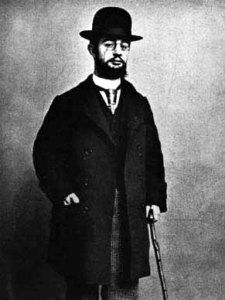(Albi 1864 - Malromé Castle, Gironde, 1901)
His full name is Henrie Marie Raymond de Toulouse-Lautrec-Monfa. A French painter and descendant of the counts of Toulouse, weak and sickly, he became deformed and a dwarf at the age of fourteen due to two falls.
The advice of René Princeteau, a painter from Bordeaux, guided him in the creation of numerous studies of horses. In 1881, he moved to Paris, entered the School of Fine Arts, and trained under Bonnat, and later in Cormon's studio, where he met Van Gogh. Wealthy, he settled in a studio in Montmartre and frequented the Mirliton, a cabaret of Aristide Bruant, and the Moulin-Rouge, for which he drew the posters that made him famous.
With his sketches and paintings, he immortalized the stars of those venues: Jane Avril, Valentin le Desosse, Yvette Guilbert, la Goulue. The latter opened a fair booth in the Place du Trône, and Toulouse-Lautrec decorated it with painted fabrics (1895) that are currently in the Louvre (Ball Game Room).
In 1889, Toulouse-Lautrec exhibited at the Salon of the Independents; in 1893, at the Goupil gallery, with success. An observer of the life in low environments, he painted one of his most important compositions in a public house: In the Salon of the Rue des Moulins (Albi Museum). He was also inspired by circus shows and those at the velodrome. His life of excess did not prevent him from engaging in intense artistic activity: drawings, pastels, paintings, advertising posters, engravings. He also undertook several trips to Belgium, Spain, and England.
His disordered existence and caustic humor have made him a legendary figure. His work has established itself, due to its qualities of vigor and originality, as one of the most valuable contributions of the late 19th century.
The boldness of his striking drawings, which combine the sharpest and cruelest realism with an extreme sobriety of means, draws attention even in his smallest sketches, as well as in his color lithographs, an art he renewed and brought to its highest degree of expressiveness.
In his early paintings, Toulouse-Lautrec shows the influences of Degas, Japanese prints, and Impressionism. However, directing him very early towards a peculiar and unmistakable expressionism, both psychological and lyrical, he created portraits of harsh realism, café scenes, cabaret, and theater, treated with a fluidity that always gives primacy to drawing.
His works are found in numerous museums, mainly in Switzerland, the USA, and especially in France, in the Louvre and the Albi Museum.
His full name is Henrie Marie Raymond de Toulouse-Lautrec-Monfa. A French painter and descendant of the counts of Toulouse, weak and sickly, he became deformed and a dwarf at the age of fourteen due to two falls.
The advice of René Princeteau, a painter from Bordeaux, guided him in the creation of numerous studies of horses. In 1881, he moved to Paris, entered the School of Fine Arts, and trained under Bonnat, and later in Cormon's studio, where he met Van Gogh. Wealthy, he settled in a studio in Montmartre and frequented the Mirliton, a cabaret of Aristide Bruant, and the Moulin-Rouge, for which he drew the posters that made him famous.
With his sketches and paintings, he immortalized the stars of those venues: Jane Avril, Valentin le Desosse, Yvette Guilbert, la Goulue. The latter opened a fair booth in the Place du Trône, and Toulouse-Lautrec decorated it with painted fabrics (1895) that are currently in the Louvre (Ball Game Room).
In 1889, Toulouse-Lautrec exhibited at the Salon of the Independents; in 1893, at the Goupil gallery, with success. An observer of the life in low environments, he painted one of his most important compositions in a public house: In the Salon of the Rue des Moulins (Albi Museum). He was also inspired by circus shows and those at the velodrome. His life of excess did not prevent him from engaging in intense artistic activity: drawings, pastels, paintings, advertising posters, engravings. He also undertook several trips to Belgium, Spain, and England.
His disordered existence and caustic humor have made him a legendary figure. His work has established itself, due to its qualities of vigor and originality, as one of the most valuable contributions of the late 19th century.
The boldness of his striking drawings, which combine the sharpest and cruelest realism with an extreme sobriety of means, draws attention even in his smallest sketches, as well as in his color lithographs, an art he renewed and brought to its highest degree of expressiveness.
In his early paintings, Toulouse-Lautrec shows the influences of Degas, Japanese prints, and Impressionism. However, directing him very early towards a peculiar and unmistakable expressionism, both psychological and lyrical, he created portraits of harsh realism, café scenes, cabaret, and theater, treated with a fluidity that always gives primacy to drawing.
His works are found in numerous museums, mainly in Switzerland, the USA, and especially in France, in the Louvre and the Albi Museum.


